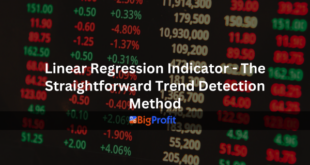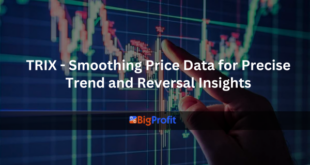Volume Analysis
A technical analyst may use volume analysis as one means of gauging the health of an uptrend by tracking changes in trading volumes. Rising markets often experience more trading volume as investors become excited by rising prices continuing their climb upwards.
Low volume may indicate a lack of interest in buying and selling shares, potentially signalling bearish trend if occurring during an uptrend.
Price and Volume Correlations
Volume analysis seeks to explain the relationship between price and volume in a stock market. It can help confirm and predict future market trends while aiding traders make informed trading decisions based on its current state.
A security’s volume can be determined by counting how many shares were traded during a particular timeframe, making this an extremely useful indicator to show demand and help investors evaluate its likelihood of success when making trading decisions.
Technical analysts often track volume as it allows them to gain a fuller picture of the market and identify possible trend lines more effectively, providing for more informed analyses.
Technical indicators may include the Positive Volume Index (PVI) and Negative Volume Index (NVI), two index calculations that track changes in trading volume to help investors predict future market trends based on volume’s effect on price.
Example: If volume increases when a stock breaks through resistance, this could signal strong demand and push it higher; conversely if volume declines when breaking out over resistance it could signal weak demand and cause it to move sideways more likely than upward.
As with bear markets, when stocks enter a bear market and start breaking below support, volume decline can indicate there is limited supply in the market and that people want to unload shares at reduced prices.
Lastly, when stocks start entering a bull market and surpass resistance, volume can indicate investor enthusiasm that will help it continue its rise. Conversely, when volumes begin declining this could signal that its rise has come to an end; any further rise may not likely occur.
On-Balance Volume
On-balance volume (OBV) is a momentum indicator which measures buying and selling pressure over time by adding or subtracting volume from each trading day. OBV can provide traders with good data-driven guidance before entering trades; however, for optimal performance it must be combined with other indicators for a complete picture of market sentiment.
Traders typically look to OBV numbers as a means to track large institutional investors that often drive up prices, because OBV serves as a measure of crowd sentiment and the trading direction of “smart money.”
Analysts often use on-balance volume as a gauge of large investor activity; tracking them as they increase prices before selling off once other investors jump onto the bandwagon. Furthermore, analysts use divergences between price and volume as a proxy of “smart money” vs. mass money movements, hoping to identify opportunities to buy against incorrect trends.
OBV (Over-Budgeted Value) is calculated by adding or subtracting volume each day based on whether or not a security closed at a higher or lower price than it had the day prior. This figure is then plotted as a line graph.
In an upswing market, an increasing OBV line can signal an upward breakout while declining OBV lines can indicate potential downward breakdown.
Bullish divergence – Bullish divergences can be identified when on-balance volume increases while price shows lower highs, potentially signalling an anticipated uptrend in price.
Bearish Divergence – When prices continue to drop while volume declines, a bearish divergence can indicate an imminent price decline. This may portend an impending trend in price that indicates downward movement.
On-balance volume was one of the earliest indicators to measure positive and negative volume flow, invented by Joseph Granville and widely utilized for trading strategies. Crypto traders also use it to gauge buying/selling pressure on cryptocurrency assets.
Positive Volume Index
The Positive Volume Index is a financial indicator which measures days with significantly increased trading volume compared to others, and can be used in combination with Negative Volume Index (NVI) to identify bull and bear markets.
Paul Dysart first created the PVI index to track market indexes; later it was modified by Norman Fosback for individual securities. It monitors changes in trade volume as well as price change of each security, and can be seen on daily timeframes, weekly time compressions or monthly time compressions.
Negative PVIs indicate overbought conditions while positive ones indicate rising prices and can even indicate oversold conditions if prices have been dropping steadily for an extended period.
This indicator is calculated based on price-volume correlation, and typically moves upward when prices increase while downward when they decrease.
Research has proven it an effective tool for detecting bear and bull market trends, alongside using other technical indicators and fundamental analysis techniques, to assess long-term trading opportunities – making it a crucial weapon in an investor’s arsenal.
Calculated for an individual stock, the ATR can be an extremely powerful indicator for identifying whether a security is under or overbought as well as trend reversals.
Note, however, that it can be subject to fluctuations and anomalies which make interpreting price direction using only this indicator difficult.
Therefore, the PVI may not always be as accurate as other indicators; therefore it should be used along with other technical indicators and price action analysis in order to identify long-term investment and trading opportunities.
Positive Volume Index is a technical indicator that can be calculated with charting software to give an analysis of daily, weekly, or monthly volume changes. Although it can be calculated on any timeframe – most commonly daily – most practitioners utilize it daily as part of their routine monitoring practices.
The positive volume index is calculated based on a one-year moving average of trading volume and changes with changes in prices; it only fluctuates on days where trading volume increases from its previous day’s level. A positive volume index that falls below its one-year average represents a strong signal with 67% accuracy that bear market conditions are approaching.
Negative Volume Index
Negative volume index (NVI) is an indicator which measures a decrease in trading volume, used as a technical indicator by traders to predict price movements and analyze market trends.
Paul Dysart created the Negative Volume Index as one of the most widely-used volume indicators. It can be calculated daily or weekly and serves to detect primary market (stock, index and ETF) movements or reversals in real time.
Contrary to other technical indicators, the NVI doesn’t require adjustment for volatility; therefore it can be calculated for any stock or index with volume data associated with it.
NVI was designed initially as a tool to identify stock market indices, but is equally applicable when applied to individual stocks. Thinly traded stocks often do not respond as effectively with its application so other methods should also be utilized for analysis.
OBV (On Balance Volume Indicator) provides another means of measuring volume. It utilizes a formula which subtracts down-day volume from previous day volume to gauge cumulative buying and selling pressure on stocks.
PVI, or Positive Volume Index, is another popular volume indicator. Calculated using the same formula as NVI, but for days when volume exceeds what was seen on prior days.
This indicator can be combined with the NVI to help identify bull and bear markets. It operates under the assumption that informed or sophisticated traders and investors tend to be most active during low-volume days while uninformed crowd-following “unsophisticated” investors tend to show more activity on days with higher volume trading activity.
However, price and volume do not always correlate directly with market movements; more often than not an event such as earnings or news may have an effect on prices.
Traders can utilize the NVI to monitor primary market movements and reversals, but it cannot provide reliable insights into short-term trends. For instance, when crossing above its one-year moving average signaling the potential start of a bull market.
 BigProfit Profit through Algo & Technical Trading
BigProfit Profit through Algo & Technical Trading



